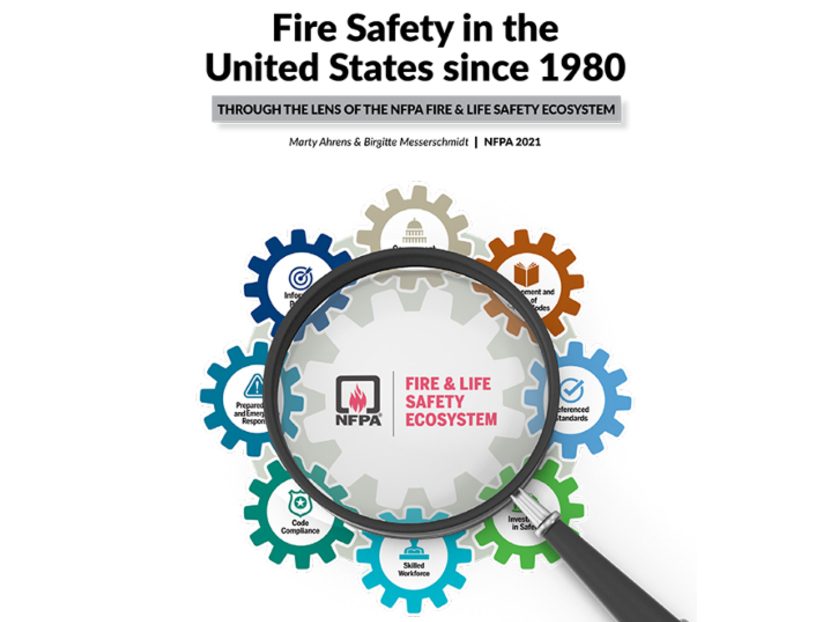NFPA and Fire Protection Research Foundation Release New Fire in the U.S. Report

Much has changed in the nearly four decades since the America Burning report was issued in 1973 and revisited in 1980. The number of fires and fire deaths in the United States has reduced dramatically and that progress has unfortunately led to fire safety taking a back seat to other societal concerns that seem more pressing. To understand the headway that has been made and the challenges that remain, the NFPA Fire & Life Safety Policy Institute commissioned the Fire Protection Research Foundation, the association’s affiliate, to examine the current state of fire safety in the United States. The new seminal report, Fire in the United States Since 1980, Through the Lens of the NFPA Fire & Life Safety Ecosystem, is expected research to be a key document with valuable insights that will help to advance fire and life safety.
While the report references success in several occupancies such as hospitals, nursing homes, schools, and hotels, the main focus that emerged from the study is residential fires. Homes have consistently accounted for the largest share of reported structure fires and most of the civilian fire deaths and injuries. And although there have been fewer fires in the U.S. than in past decades, statistically, if a home fire is reported, occupants are more likely to die today than 40 years ago. In fact, research shows the following:
- Every 24 seconds, a U.S. fire department responds to a fire somewhere in the country
- Nationwide, a civilian dies in a fire every 3 hours and 10 minutes
- In the U.S., a home fire injury occurs every 43 minutes
The 63-page Fire in the United States Since 1980, Through the Lens of the NFPA Fire & Life Safety Ecosystem report shows, in part, that:
- The most successful recipe for fire safety in the built environment has been the implementation of fire safety technologies through mandated codes and standards
- NFPA Fire & Life Safety Ecosystem elements — government responsibility, development and use of current codes, and an informed public — have had an obvious impact on the fire experience
- Approaching fire safety as a system, and not individual bits and pieces, provides an opportunity to unravel the complex and ongoing fire safety challenge for society
- Smoke alarms are a huge success story
- Cooking remains the leading cause of home fires and injuries
- Smoking has the been the leading cause of home fire deaths for roughly four decades
- Fire deaths of children under fire have dramatically declined, but there has been little change in older adult death tolls
- States with higher fire death rates correlate with larger percentages of people who have a disability; are current smokers; have incomes below the poverty line; live in rural areas; or are either African American, Black, Native American, or Alaskan Native
- Wildfire is becoming the dominant type of fire that causes catastrophic multiple deaths as well as large losses
The new study analyzed fire data and other research from the past 40 years to provide a snapshot of what has influenced safety. Additionally, catastrophic multiple-death fires and fires in the wildland/ urban interface (WUI) were looked at because they have the potential to cause significant human loss.
“Increasing the understanding of what has impacted fire safety can help identify what needs to be done to further reduce death and destruction,” NFPA President and CEO Jim Pauley, said. “Year after year, we see nearly 3,000 home fire deaths in the U.S., one of the most advanced countries in the world, and the problem is markedly worse in countries that don’t have a fully developed fire and life safety ecosystem yet. As a global authority committed to eliminating loss due to fire, electrical, and other hazards, NFPA will continue to advocate for the protection of people and property as we have for 125 years. But we cannot do the work alone. We need all of the elements of the Ecosystem working to connect the dots on safety.”
As the report name suggests, the new benchmark research was conducted with the NFPA Fire & Life Safety Ecosystem in mind. NFPA introduced the Ecosystem in 2018 so that professionals, practitioners, and the public had a framework that identified the key elements that play a critical role in fire, life, and electrical safety. The eight components are government responsibility, development and use of current codes, referenced standards, investment in safety, a skilled workforce, code compliance, preparedness and emergency response, and an informed public. When all the Ecosystem elements work together, the result is a fully functioning system that can benefit everyone. If one or more of the components fails, the system breaks down and tragedies can occur.
To download the full report, click here.




